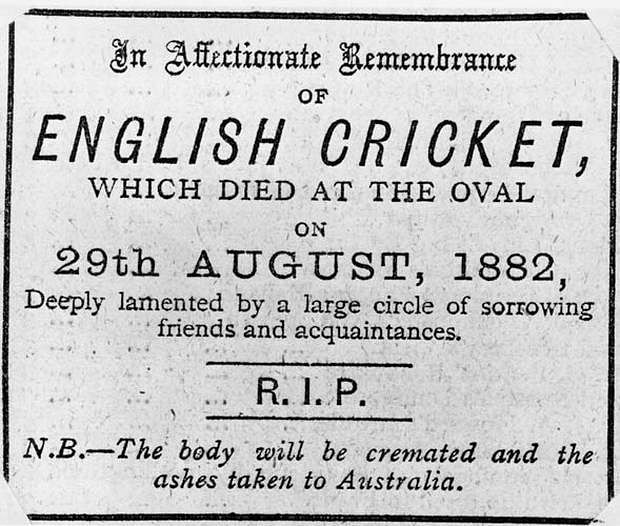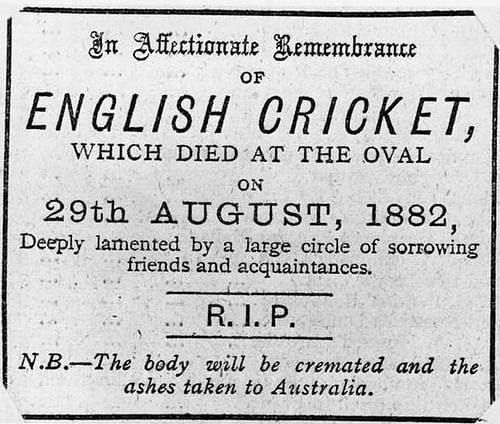
Is the Ashes still cricket's greatest rivalry?

“In Affectionate Remembrance of English Cricket, which died at the Oval on 29th August 1882, Deeply lamented by a large circle of sorrowing friends and acquaintances /R.I.P. / N.B. – The body will be cremated and the ashes taken to Australia.”
The Sporting Times, September 1882
And so it began. Reginald Brooks’ amusing mock-obituary in The Sporting Times beautifully showcased the English’s masterful grasp of wit. In one stroke of genius, cricket’s most famous conflict was not only born but it had been given a name that was to become forever associated with the sport: the Ashes.
The Australian “Demon Bowler” Frederick Spofforth bulldozed through an England lineup featuring W.G. Grace, taking seven for 44 to condemn the Poms to a seven-run loss in their pursuit of 85. Such humiliation prompted Brooks’ to declare the death of English cricket and the rest is history.
It’s a legend that has lived on, and a battle that has raged for over 130 years between England and Australia, all for an urn that is perhaps sport’s tiniest trophy. And it wasn’t always friendly. Bodyline tactics inspired by England captain Douglas Jardine in 1932-33 brought the game into disrepute with fast bowlers instructed to deliver the ball on a leg stump line, hoping that a batsman would fend the ball to one of the many fielders behind square leg.
It’s a theory that breached the boundaries of sportsmanlike conduct and was subsequently banned, but Jardine’s style made it succinctly clear that this was the fiercest clash of all. In the decades that followed, the Bradmans and Bothams have left their own indelible marks on the never-ending war. But as we near the start of the latest chapter, the question must be posed: is the Ashes still cricket’s greatest rivalry?
Naturally, it will depend on whom you ask and what they have had the fortune to witness. It’s also a slightly ambiguous query. What determines greatness? There are plenty of parameters. “One man’s trash is another man’s treasure,” as they say. The beauty of debate is that while convincing someone of your argument who is in staunch disagreement is nigh on impossible, we sure do our damnedest to try. But enough philosophy.
Cricket in 2015 is a different beast from what it was at the beginning of this century, nevermind in 1882. The advent of one-dayers brought with them white balls, coloured clothing and dollar signs visible as far as the eye can see. But while the World Cup provides a superb spectacle, it is unanimously accepted that Tests are the pinnacle. And, although franchise cricket is booming, the threat of club usurping country has been warned off, at least for now. So if there is a rivalry to trump the Ashes, it’s one close to home.
Does the Ashes still compete with India vs Pakistan?
In terms of sheer numbers, India-Pakistan matches attract attention like no other and, as they become scarcer, the intrigue surrounding each only heightens. An estimated one billion viewers tuned into their Adelaide encounter in this year’s World Cup – over 11 times the combined population of Australia and the United Kingdom. These are figures the Ashes will never be able to compete with, therefore it has to fight back elsewhere.
Political tensions have restricted bilateral series between India and Pakistan for the majority of the past decade, limiting their meetings almost entirely to ICC tournaments – the exception coming in 2012, when India hosted their adversaries for a three-match ODI series. The two have not played a Test match against each other since December 2007, seven and a half years ago.
There is speculation that a glut of India-Pakistan matches could be on the horizon, and while hope springs eternal it is very much a waiting game. Until the two teams are back duelling on a regular basis, their rivalry, as massive as it is, cannot currently be considered cricket’s greatest.
While India-Pakistan contests have become all too rare, the Ashes is in danger of going too far in the other direction. Ultimately, the series is an extremely marketable product, hence the cash cow will be milked for as long as it remains profitable. Back-to-back Ashes took place in 2013 and Australia are already back in England to take to the field again.
History or quality, what’s your pick?
Historically, they would collide roughly every two years, with each country staging the event every four. The risk of overkill is one often not realised until it is too late. It hasn’t devalued the show yet, but the Big Three’s power grab is a cause for concern.
The quality of each Ashes varies on the strength of the two teams and there will always be cries that a hypothetical match-up between X and Y would be be better - right now, South Africa versus Australia might be viewed as the marquee Test series. For pure excitement, topping the England-New Zealand tour that just concluded will be tough. But does that make either a bigger rivalry than the Ashes? Of course not.
What the Ashes possesses that no other bilateral series does is the longevity. The hubbub whipped up whenever England and Australia tussle has survived decades of one-sidedness. Inevitably, as it has the power to do that, the eventual momentum shift serves to create unmatchable drama. Case in point: 2005. The Ashes is also one of the few series that continues to maintain a five-Test schedule – the most thorough examination of a cricketer around.
The two are to commence their newest skirmish in early July, a close and thrilling series is not guaranteed – this is after all sport, not a soap opera. Australia are heavy favourites and the urn’s defenders despite England showing a new lease of life in recent weeks, but they are without an Ashes triumph away from home since 2001. Ricky Ponting never managed it and Michael Clarke will be keen for the hoodoo not to dent his growing legacy. Factor in that it will be an Australian – Trevor Bayliss – who looks to mastermind England’s challenge from the coaching chair and you have a wealth of talking points. It is never dull when the two sides meet.
It may be superseded by other matches in viewing figures, and perhaps there are higher quality rivalries at this moment in time, but none have the history of the Ashes. These oldest of foes have defined everything Test cricket stands for – as you would expect since it wasn’t until the 31st Test match that a team other than the aforementioned two took part. No, the Ashes is still cricket’s greatest rivalry and will remain so while Tests rule the roost and organisers relent from saturating the market for their own greed.
Doubtful? Just wait and see. A fascinating summer lies ahead.